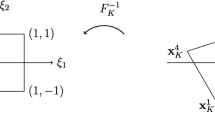Abstract
An efficient nonlinear multigrid method for a mixed finite element method of the Darcy–Forchheimer model is constructed in this paper. A Peaceman–Rachford type iteration is used as a smoother to decouple the nonlinearity from the divergence constraint. The nonlinear equation can be solved element-wise with a closed formulae. The linear saddle point system for the constraint is reduced into a symmetric positive definite system of Poisson type. Furthermore an empirical choice of the parameter used in the splitting is proposed and the resulting multigrid method is robust to the so-called Forchheimer number which controls the strength of the nonlinearity. By comparing the number of iterations and CPU time of different solvers in several numerical experiments, our multigrid method is shown to convergent with a rate independent of the mesh size and the Forchheimer number and with a nearly linear computational cost.


Similar content being viewed by others
References
Adams, R.A.: Sobolev Spaces. Academic Press, New York (1975)
Arnold, D.N., Falk, R.S., Winther, R.: Preconditioning in \(H(\text{ div })\) and applications. Math. Comp. 66(219), 957–984 (1997)
Arnold, D.N., Falk, R.S., Winther, R.: Multigrid in \(H(\text{ div })\) and \(H(\text{ curl })\). Numer. Math. 85(2), 197–217 (2000)
Aristotelous, A., Karakashian, O., Wise, S.: A mixed discontinuous Galerkin, convex splitting scheme for a modified Cahn–Hilliard equation and an efficient nonlinear multigrid solver. Discrete Contin. Dyn. Syst. Ser. B 18(9), 2211–2238 (2013)
Aziz, K., Settari, A.: Petroleum Reservoir Simulation. Applied Science Publishers LTD, London (1979)
Bank, R.E., Douglas, C.C.: Sharp estimates for multigrid rates of convergence with general smoothing and acceleration. SIAM J. Numer. Anal. 22, 617–633 (1985)
Braess, D., Sarazin, R.: An efficient smoother for the Stokes equation. Appl. Numer. Math. 23(1), 3–20 (1997)
Brandt, A.: Multi-level adaptive solutions to boundary-value problems. Math. Comp. 31(138), 333–390 (1977)
Briggs, W.L., Henson, V.E., McCormick, S.F.: A Multigrid Tutorial, 2nd edn. SIAM, Philadelphia (2000)
Chen, L.: \(i\)FEM: an integrated finite element methods package in MATLAB. Technical report, University of California at Irvine (2009)
Chen, L.: Multigrid methods for saddle point systems using constrained smoothers. Comput. Math. Appl. 70(12), 2854–2866 (2015)
Chen, L.: Multigrid methods for constrained minimization problems and application to saddle point problems. arXiv:1601.04091, pp. 1–27 (2016)
Ciarlet, P.G.: The finite element method for elliptic problems. North-Holland, Amsterdam (1978)
Forchheimer, P.: Wasserbewegung durch Boden. Z. Ver. Deutsch. Ing. 45, 1782–1788 (1901)
Girault, V., Wheeler, M.F.: Numerical discretization of a Darcy–Forchheimer model. Numer. Math. 110, 161–198 (2008)
Hackbusch, W.: Multigrid Methods and Applications. Springer, Heidelberg (1985)
López, H., Molina, B., Salas, J.J.: Comparison between different numerical discretizations for a Darcy–Forchheimer model. ETNA 34, 187–203 (2009)
Mardal, K., Winther, R.: Uniform preconditioners for the time dependent Stokes problem. Numer. Math. 98(2), 305–327 (2004)
Olshanskii, M., Peters, J., Reusken, A.: Uniform preconditioners for a parameter dependent saddle point problem with application to generalized Stokes interface equations. Numer. Math. 105(1), 159–191 (2006)
Pan, H., Rui, H.: Mixed element method for two-dimensional Darcy–Forchheimer model. J. Sci. Comp. 52, 563–587 (2012)
Park, E.J.: Mixed finite element method for generalized Forchheimer flow in porous media. Numer. Methods Partial Differ. Equ. 21, 213–228 (2005)
Reusken, A.: Convergence of the multigrid full approximation scheme for a class of elliptic mildly nonlinear boundary value problems. Numer. Math. 52, 251–277 (1988)
Rui, H., Liu, W.: A two-grid block-centered finite difference method for Darcy–Forchheimer flow in porous media. SIAM J. Numer. Anal. 53(4), 1941–1962 (2015)
Rui, H., Pan, H.: A block-centered finite difference method for the Darcy–Forchheimer model. SIAM J. Numer. Anal. 50(5), 2612–2631 (2012)
Rui, H., Zhao, D., Pan, H.: A block-centered finite difference method for Darcy–Forchheimer model with variable Forchheimer number. Numer. Methods Partial Differ. Equ. 31, 1603–1622 (2015)
Ruth, D., Ma, H.: On the derivation of the Forchheimer equation by means of the averaging theorem. Transp Porous Media 7, 255–264 (1992)
Salas, J.J., López, H., Molina, B.: An analysis of a mixed finite element method for a Darcy–Forchheimer model. Math. Comput. Model. 57, 2325–2338 (2013)
Tai, X.: Rate of convergence for some constraint decomposition methods for nonlinear variational inequalities. Numer. Math. 93(4), 755–786 (2003)
Tai, X., Xu, J.: Global and uniform convergence of subspace correction methods for some convex optimization problems. Math. Comput. 71(237), 105–125 (2001)
Wang, Y., Rui, H.: Stabilized Crouzeix–Raviart element for Darcy–Forchheimer model. Numer. Methods Partial Differ. Equ. 31, 1568–1588 (2015)
Wise, S.: Unconditionally stable finite difference, nonlinear multigrid simulation of the Cahn–Hilliard–Hele–Shaw system of equations. J. Sci. Comp. 44(1), 38–68 (2010)
Yavneh, I., Dardyk, G.: A multilevel nonlinear method. SIAM J. Sci. Comp. 28(1), 24–46 (2006)
Acknowledgements
We would like to thank the anonymous referee for the valuable suggestions and careful reading, which have helped us to improve the presentation.
Author information
Authors and Affiliations
Corresponding author
Additional information
The work of Jian Huang and Hongxing Rui was supported by the National Natural Science Foundation of China Grant No. 11671233, and in part by the Science Challenge Project No. JCKY2016212A502. Long Chen was supported by NSF Grant DMS-1418934, in part by NIH Grant P50GM76516, and in part by the Sea Poly Project of Beijing Overseas Talents. The work of Jian Huang was supported by 2014 China Scholarship Council (CSC).
Rights and permissions
About this article
Cite this article
Huang, J., Chen, L. & Rui, H. Multigrid Methods for a Mixed Finite Element Method of the Darcy–Forchheimer Model. J Sci Comput 74, 396–411 (2018). https://doi.org/10.1007/s10915-017-0466-z
Received:
Revised:
Accepted:
Published:
Issue Date:
DOI: https://doi.org/10.1007/s10915-017-0466-z




